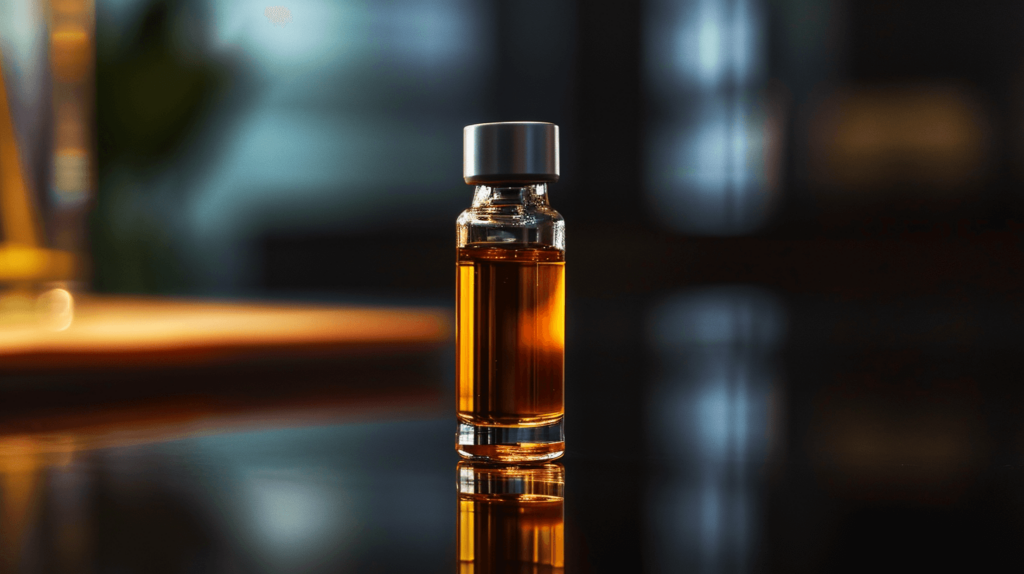
Is Testosterone Therapy Safe?
While there are risks, testosterone replacement therapy is a safe treatment to help treat the symptoms of low T.
Low testosterone comes with age, and, unfortunately, a slew of negative symptoms arrive with it. To counteract these symptoms, healthcare professionals have introduced testosterone replacement therapy (TRT). The question becomes: Is testosterone therapy safe?
Assessing this treatment’s safety involves looking at its potential risks and rewards. It’s not a one-size-fits-all answer; this article dives into the evidence to give you a nuanced view of when and how testosterone replacement therapy can be a safe option for those needing hormonal support.
Key Takeaways
- Providers use testosterone replacement therapy to treat men with low testosterone levels. It can improve sexual function, energy, muscle mass, and bone density.
- While TRT can provide benefits, it also poses potential risks like infertility, acne, and sleep apnea.
- Patients considering testosterone therapy should undergo a thorough evaluation and regular monitoring of blood parameters with a healthcare professional, as responses to treatment can vary significantly.
- When provided and monitored correctly, testosterone replacement therapy is safe and effective.
Understanding Testosterone Therapy

Testosterone therapy, also known as testosterone replacement therapy (TRT), is a form of hormone treatment designed for men with low testosterone levels or hypogonadism and who have symptoms that may include fatigue, erectile dysfunction, muscle wasting, and decreased sexual desire. The therapy works by providing supplementary testosterone to the body, usually in the form of injections, pellets, or gels.
To assess an individual’s testosterone levels, a healthcare professional typically collects a blood sample, preferably in the morning when testosterone levels peak.
While TRT provides many expected benefits, one must appreciate that testosterone therapy doesn’t fit everyone equally and that there are certain risks associated with the treatment.
The Benefits of Testosterone Therapy

Testosterone therapy offers a host of potential benefits. For instance, it can boost energy levels by promoting vitality and restoring balance to the body’s functions. Additionally, it can enhance libido, thereby increasing sex drive and desire in men with low testosterone levels.
Empirical studies have substantiated several advantages of testosterone replacement therapy for men. These include:
- Enhancing muscle mass and strength
- Reducing fat mass
- Improving sexual function
- Enhancing mood
- Increasing libido
Individual results may differ based on age, testosterone deficiency severity, and overall health, which can impact the therapy’s effectiveness.
Potential Risks and Side Effects
As with any medical treatment, TRT carries potential risks and side effects. These risks include:
- Acne or other skin reactions
- Sleep apnea
- Possible prostate enlargement (benign prostatic hyperplasia)
- Possible breast enlargement
- Infertility
- Testicular atrophy
- Elevated red blood cell count, increasing the risk of blood clots
These side effects, though they might sound alarming, don’t occur in all men undergoing testosterone therapy. Additionally, an experienced healthcare provider will know how to mitigate risks. Their occurrence primarily concerns personal health factors and the body’s response to the treatment. Hence, frequent monitoring and discussions with a healthcare provider become integral for managing potential risks.
Testosterone Therapy and Cardiovascular Health

A more significant concern for many men who are interested in testosterone treatments is cardiovascular risk. However, considerable evidence indicates that TRT does not increase the risk of cardiovascular disease. It may even benefit heart health, such as coronary vasodilation and increased coronary blood flow.
In addition to potential heart health benefits, long-term testosterone therapy can enhance liver function and decrease liver enzymes. These effects are noteworthy as the liver is crucial in maintaining overall health and well-being.
While these findings are promising, each person is unique, and the body’s response to testosterone therapy can vary significantly. Thus, continuous monitoring of cardiovascular health during testosterone therapy is of utmost importance.
TRT and Prostate Cancer
Another common concern with those who are considering testosterone treatment is the relationship between testosterone therapy and prostate cancer. According to recent studies, testosterone treatments do not increase a man’s risk of developing prostate cancer. The research shows that TRT may have a potentially protective effect and reduce the risk of aggressive prostate cancer, which is associated with low T levels.
That said, prostate cells are stimulated by testosterone, so be extra vigilant about cancer screenings.
Monitoring and Managing Testosterone Therapy

Healthcare providers need to consistently monitor and manage testosterone therapy to help patients obtain the best results and minimize potential risks. We recommend blood tests at least every six months during testosterone replacement. These tests should measure:
- Total testosterone levels
- CBC
- PSA Total
- Estradiol
Moreover, prostate exams are crucial for individuals undergoing testosterone therapy due to the potential of testosterone to worsen existing prostate cancer. Regular monitoring is essential for early detection of any potential issues.
Testosterone Therapy for Different Age Groups
The effects of testosterone therapy can vary across different age groups. For older men diagnosed with hypogonadism, testosterone therapy has demonstrated advantages, including enhanced bone density and strength, as well as improved sexual activity, desire, and erectile function. Recent testosterone trials have further supported these findings.
Healthcare professionals generally begin to recommend testosterone therapy after the age of 40, as symptoms of low testosterone may start to manifest in a man’s 30s. This recommendation stems from the understanding that testosterone levels naturally decrease with age, potentially causing symptoms like low libido, fatigue, and muscle weakness.
When to Consider Testosterone Therapy
Deciding the right time for testosterone therapy is a significant step. Men should only consider testosterone therapy when they have confirmed they have low testosterone levels and the accompanying symptoms. Potential indicators for the necessity of testosterone therapy may include persistent low libido, unexplained anemia, and signs of testosterone deficiency such as weakness and fatigue.
Alternatives to Testosterone Therapy

For those wary of the potential risks of testosterone therapy or those who are not suited for it, there are alternative treatments and lifestyle changes that may help improve symptoms of low testosterone. For instance, engaging in regular physical activity can result in immediate alterations in serum testosterone levels. Consistently partaking in physical exercise, particularly resistance exercise and strength training, has been linked to elevated testosterone levels and could serve as an advantageous approach for enhancing and maintaining optimal testosterone levels in males.
The diet also plays an important role. Consuming the following foods may also naturally increase testosterone:
- fatty fish
- dark leafy greens
- cocoa products
- avocados
- eggs
- berries
- cherries
- pomegranates
- milk and dairy products
- legumes
- honey
- onions
Additionally, stress management can also positively impact testosterone production. Effective stress management can decrease stress levels, which can help maintain hormonal balance, ultimately alleviating symptoms associated with low testosterone.
Enclomiphene and Low Testosterone
Enclomiphene is an exciting new alternative treatment option for men with low testosterone levels. It’s an orally administered, non-steroidal medication that stimulates the natural production of testosterone in the body. Unlike testosterone replacement therapy, which directly supplements the body with testosterone, Enclomiphene works by blocking estrogen receptors in the brain. This blockage tricks the body into thinking it needs to produce more testosterone, naturally increasing testosterone levels. The natural increase in testosterone can result in improved energy, mood, and sexual function, similar to the effects of testosterone treatments, but without the need for injections or the risk of specific side effects associated with direct testosterone supplementation.
For instance, one of the critical risks of TRT is that it can suppress the body’s natural production of testosterone, potentially causing testicular shrinkage and infertility. Since Enclomiphene stimulates the body’s testosterone production, it does not carry these risks. Therefore, Enclomiphene might be a more suitable option for men who are concerned about maintaining their fertility while addressing low testosterone levels.
Moreover, TRT can sometimes lead to an overproduction of red blood cells, increasing the risk of blood clots. Enclomiphene, on the other hand, does not have this effect.
It’s also worth noting that you take Enclomiphene orally, which may be more convenient for some individuals than the injections or gels often used in TRT.
Summary
In conclusion, testosterone replacement therapy can offer significant benefits for men with hypogonadism or low testosterone levels, including increased energy, libido, bone density, and muscle strength. However, it’s not without its potential risks, which may include acne, sleep apnea, infertility, blood clots, and testicular atrophy.
Ultimately, it would be best if you decided to undergo TRT after thoughtful consideration and a detailed discussion with a healthcare professional. Discussing your medical history to see if you are at an increased risk for diseases is essential, and it’s crucial to weigh the potential benefits against the possible risks and consider alternatives such as lifestyle modifications and dietary changes.
Frequently Asked Questions
You can stay on testosterone therapy for as long as you feel it is benefiting you. With that said, if you stop TRT, we generally see testosterone drop to the baseline levels they were at before treatments began.
You can stop testosterone therapy whenever you like. With that said, we always recommend a post-cycle treatment to ensure your body is working appropriately. Unfortunately, if you stop testosterone treatments, your T levels will likely return to their original baseline, which is likely to cause a return of low testosterone symptoms such as low libido, erectile dysfunction, fatigue, mood changes, and poor body composition.
While a 30-year-old man can take testosterone injections, they will be at an increased risk of infertility. If they are trying to procreate, we recommend trying Enclomiphene before TRT.
Testosterone therapy is a hormone treatment for men with hypogonadism or low testosterone levels, aiming to improve energy, libido, mood, alertness, and cognitive function.
Testosterone therapy does not increase the risk of cardiovascular disease. It may even benefit heart health, such as coronary vasodilation and increased coronary blood flow.
